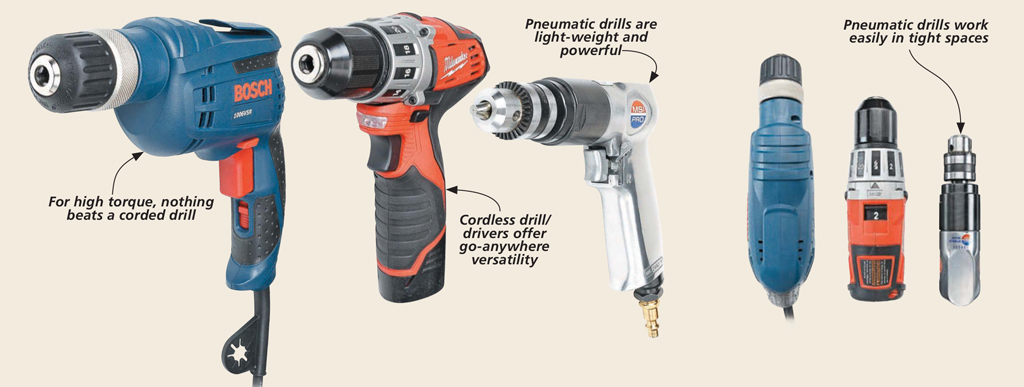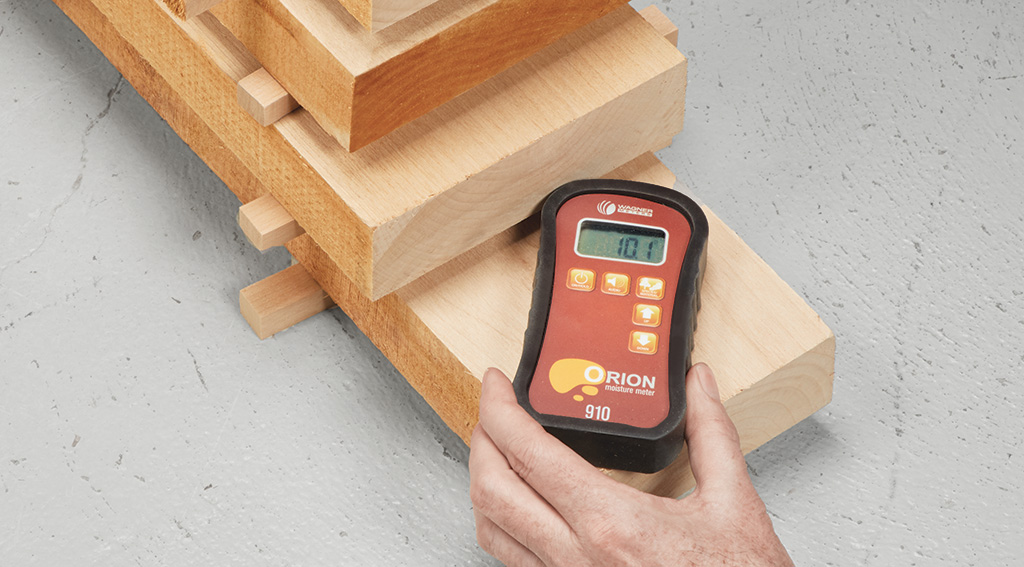 A hand-held drill is an essential tool for any woodworking shop. But when you consider the power supply, speed, size and capacity of different drills, finding the right drill for the task at hand might be a tough decision. One way to narrow down the choices is to focus on how the drill is powered: cordless, corded, or pneumatic. Each type of drill is best suited for specific tasks.
A hand-held drill is an essential tool for any woodworking shop. But when you consider the power supply, speed, size and capacity of different drills, finding the right drill for the task at hand might be a tough decision. One way to narrow down the choices is to focus on how the drill is powered: cordless, corded, or pneumatic. Each type of drill is best suited for specific tasks.
CORDLESS. Battery-powered drills are pretty much stantard fair in a woodworking shop. Since there’s no cord to get in the way, you can take them anywhere. Newer models are available in a range of sizes and voltages. They’re usually light and easy to handle, like the one shown in the photo below.


The newer, lithium ion batteries recharge quickly and hold a charge for months in storage. This means you don’t have to charge the battery before each use, so you can just grab it and go.
Where a cordless drill excels is driving screws. Most drivers have a clutch on the chuck that regulates torque and allows you to drive screws gently without stripping out the holes or screw heads. The clutch actually disengages the chuck so it stops turning even though the motor is still running. Two speed range options also aid in driving screws (photo below). I use the slow speed to drive screws and the higher speed to drill small holes.


CORDED DRILLS. Cordless drill/ drivers won’t do every job, though. They don’t have the power to drill large holes or drive long screws into hardwood. For that kind of work, it’s best to use a corded drill.
The higher voltage of a corded drill provides more torque for heavy or extended use. For example, if I have a large hole to drill with a hole saw, a corded drill makes short work of it. (The drill shown in the main photo will handle a hole saw up to 1 ⅜" diameter.) I also like to use a corded drill for drilling holes for pocket hole joinery. With a corded drill the power never runs out or bogs down, so you can use it for drilling metal or other non-wood materials as well.
The weight of a corded drill can produce fatigue after prolonged use, though. And no clutch means driving screws takes more finesse.
PNEUMATIC DRILL. One type of power supply that’s often overlooked is air. But if you have an [air compressor](https://www.woodsmith.com/review/best-mini-air-compressor/), it’s an option worth considering.
 Air-powered tools combine the benefits of both the corded and [cordless drill](https://popularwoodworking.com/review/cordless-drill/). First, they’re light weight and easy to handle. Second their power is continuous, if your [air compressor](https://www.woodsmith.com/review/best-air-compressor/) is large enough to provide the needed air. The air requirements for most drills are available from the manufacturer, so check the packaging to see if your compressor can handle the task.
While older air-powered drills only drive forward, newer models have reverse as well, like the one shown in the photo above. You can also vary the speed depending on how hard you pull the trigger. Because they use a common keyed chuck, pneumatic drills take the same bits and attachments as any other drill.
I like to use a pneumatic drill where I have limited clearance. They’re great at getting into tight places, because the overall length is much shorter than most other drills. Since a pneumatic drill doesn’t have a motor, they usually aren’t as large as corded or even cordless drills. You can see what I mean in the lower, right photo on the opposite page.
Air-powered tools combine the benefits of both the corded and [cordless drill](https://popularwoodworking.com/review/cordless-drill/). First, they’re light weight and easy to handle. Second their power is continuous, if your [air compressor](https://www.woodsmith.com/review/best-air-compressor/) is large enough to provide the needed air. The air requirements for most drills are available from the manufacturer, so check the packaging to see if your compressor can handle the task.
While older air-powered drills only drive forward, newer models have reverse as well, like the one shown in the photo above. You can also vary the speed depending on how hard you pull the trigger. Because they use a common keyed chuck, pneumatic drills take the same bits and attachments as any other drill.
I like to use a pneumatic drill where I have limited clearance. They’re great at getting into tight places, because the overall length is much shorter than most other drills. Since a pneumatic drill doesn’t have a motor, they usually aren’t as large as corded or even cordless drills. You can see what I mean in the lower, right photo on the opposite page.
While you can purchase an air-powered drill for around $35, a high-quality pneumatic drill will set you back about $200. But the tool has few working parts, so it will last virtually forever if kept oiled (photo above).
Depending on the type of work you do, you may want to have all three drills on hand in your shop. But if you’re just getting started, match the drill to your current need, and you’ll get better results with less frustration.












